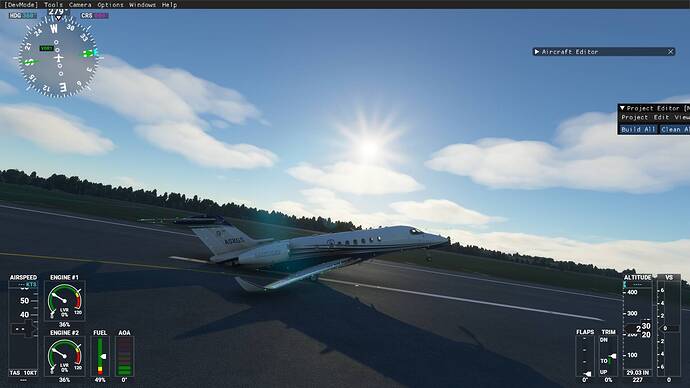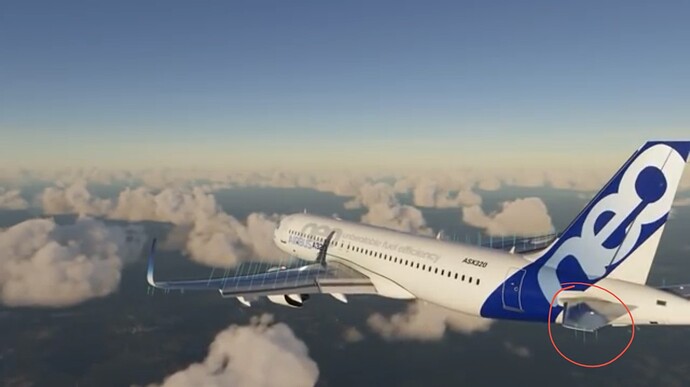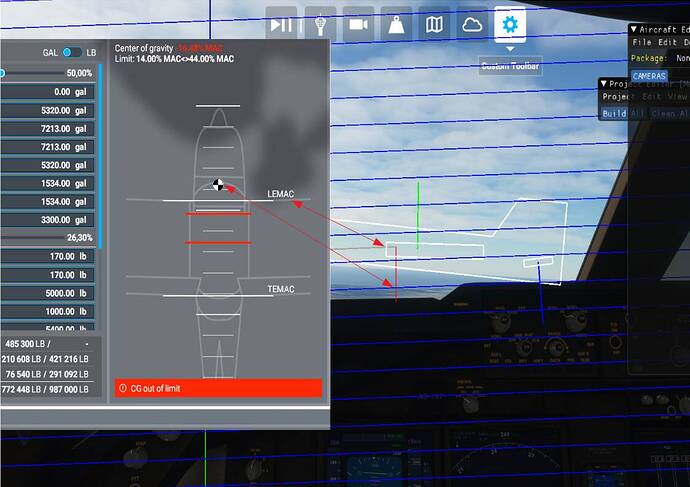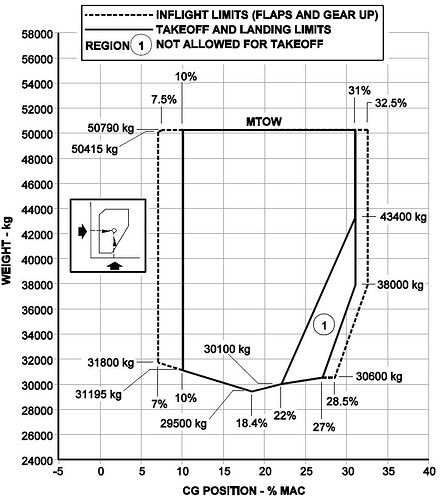Few notes about aircraft pitch stability. That is interesting that larger aircraft dont become unstable, even very veird cog positions. One possible reason other than flight physics are wrong is some artificial stability setting, but where. I havent any assist or helpers and modern flightmodel is on. When I looked elevator force vectors on developer mode they behaves like aircraft has FBW system (not A320 at this case). When I pull stick back it cause spikes to forces but it balances pretty quickly, I dont know is this like RL behaviour. Cog test, aircraft sitting on tail when stopping but no handling issues during approach, maybe little less stable but not much.
Problem is that everything is in reverse, including the CP movement with angle of attack so in the end the aircraft has some form of stability but response to flap / slat movement, ground effect, fuel consumption, drag is all wrong. You could see the pitching moments in developer mode as well, that one is more useful than visualizing the forces. The spikes might be caused due to the aircrafts inertia? In real life when making abrupt control inputs the aircraft will continue the original trajectory for a moment due to inertia after which the angle of attack starts to change and forces reduce accordingly for a fixed stick position.
Is it possible that CP vs aoa movement is adjustable with this table: pitch_moment_aoa_table = -3.15:0, -0.8:-1.599, -0.4:-1.272, -0.2:-0.686, -0.1:-0.348, 0:0, 0.2:0.742, 0.23:0.834, 0.26:0.92, 0.29:1.117, 0.31:1.224, 0.4:1.508, 0.8:1.962, 3.15:0
Flightmodel file has also that: pitch_moment_aoa_0 = -0.45332 maybe some base pitch moment or it is ignored when both are in file.
I dont see big problems with ground effect, it is adjustable in flightmodel file. How accuracy it affects drag and pitch moments is other question, too much lift is not problem when reduce ground effect value.
The pitch moment -aoa table is functioning with the modern flight model, but I don’t think the pitching moment variables are.
As you know, I disagree that the ground effect is adjustable in the flight model cfg file. I’ve tried values from -10 to +10 for Machs from 0 to 0.9 with the A320 and have not seen any affect.
Main reasons why I am expect that ground effect works this way is I have payware aircraft wich has three pairs numbers in table 0:x, 0.xx:1.x, 0.x:1.xx I replaced some numbers to letters because I dont now is it ok share this payware aircraft information here. And other is roughly testing, fly correct approach path without flaring to runway and follow how sinkrate vary, and same with modified value 0.054:1.03 or 0.054:1.001. After that try normal landing. This can be affected with many other factors also but with CJ4 this produce pretty good results.
One challenging thing with these modifications is which numbers are in correct area and how it works with total abrupt values.
I tested some modifications to pitch moment table but nothing happen…
Some tables use degrees and some others radians, not too easy…
I don’t know much if anything about the SDK, modifying .cfg files etc. I only know how it is supposed to be in real life. You could change the CP movement maybe but I’m not sure it solves the problem. The CP position itself is wrong (in front of CG), the horizontal stabilizer likely also needs to be modified as it seems at normal angles it produces an up instead of down-force (not sure, once again I’m not a programmer).
From what I have seen in the developer mode by visualizing the forces and pitching moments and in combination with what would happen in the real world in this case the ground effect works in reverse.
In ground effect the wing downwash angle reduces creating a lower angle of attack on the stabilizer. Normally this creates a nose-down pitching moment in real life, since the stabilizer in MSFS is causing a nose down instead of nose-up pitching moment in flight and the stabilizer AOA is reducing in ground effect the net effect will be nose-up.
That is really true that CP location adjustments not resolve main problem and also wrong CP vs CG locations also affects landing behaviour. XP11 represents very good (I believe, I am not rw pilot) how big troubles cause wrong CG location and it has flightmodel dump file wich shows detailed information from flightmodel but with this sim information is more limited.
Ground effect also reduce stall AOA if I understand correctly, how noticeable this is in RL?
Well in ground effect there is a natural nose down tendency (aircraft trimmed before entering ground effect), some planes this might not be so pronounced and they might have a floating tendency. Its important to understand that the lift is increased for the same angle of attack whilst in ground effect, this is what is perceived as floating, at the same time the nose tends to pitch down as mentioned before so it depends how far these cancel each other out.
On jets the ground effect is not that noticeable (as far as I know, haven’t flown every type), especially because there is a nose down tendency when selecting thrust levers to idle and the the CL / a curve is much more flat on a jet. The increase of effective angle of attack won’t have such a great effect on CL as on a straight wing.
The reduced critical angle of attack itself isn’t noticeable as you normally don’t go that far, if you would hold the aircraft off until stall you would notice you are able to fly well below stall speed. Its more noticeable during take-off should you rotate early, you’ll notice the aircraft tends to sink back onto the runway when trying to climb out of ground effect.
Hey, one can only hope! It isn’t in the current version yet, though. I will really be looking forward to this if they have actually fixed it.
Notice that’s with flaps down, and the wing lift vectors have really moved aft on the wing. Everything I have looked at has been with flaps up, where the lift vectors are on the leading edge and the 5-% chord point. If I move them back via changing the aerodynamic center in the .cfg file, it causes the cg to move forward. I could not find a way to move the aerodynamic center independent of the cg.
I noticed that there are some new variables available in the flap setting area, one of which is labeled as aft col movement. I will have to experiment with that.
Looking at that shot again, it looks kind of weird. Like full flaps, but gear up and almost looks like level flight.
Edit: Just watched the video again, and the shot you took was in the area talking about future improvements, and it was in regards to pitch changes due to flaps. Your screenshot is just after flap deployment. Seconds later, it went back to a small lifting force on the tail. And you can see how the lift forces on the wing go from being further aft fo back to where they were. So it looks like this only changes the pitch force when flaps are first deployed or retracted. Not the steady state condition.
And, I just tried using the new variable for moving the center-of- lift aft with flap deflection, and it did not work. Must not be enabled yet.
Yes its in the future improvements, I think the shot actually shows flap retraction and I noticed the stabilizer down force is slowly changing into a stabilizer up-force during the shot but the video doesn’t run long enough to see this happening. So maybe I was a little too quick to conclude they’ve solved it in a future update. Seeing down-force on the horizontal stabilizer instead of an up-force got me all excited  .
.
I made few tests but apparently this whitebox in developer mode and Lemac and Temac markings in menu window are different things
At least the forces look ok! But with the CP moving in the wrong direction with changes in angle of attack it should make the aircraft unstable  . How does it handle?
. How does it handle?
Not especially stable. CG need little bit readjustments, elevator force is now quite high.
Hello again,
I did some research and asking since I wasnt sure about the horizontal stabilizer. Acutally the AOA of the hs becomes bigger and therefore produces more lift (in the negative direction), as you stated in the T-Tail design. The downwash does not induces a negative AOA for the hs, but does reduces the AOA of the hs. Anyways, doesnt really changes a thing here. I was just nerdy to figure that out.
Lets see how well the improvements of the aerodynamics are in the future. I hope they will also include some gyro precession at the prop someday 
It is a rabbit hole still, on small GA aircraft the wing downwash does have a substantial effect on the horizontal stabilizer AOA. I did check in X-plane (no idea how accurate it actually is) but it does show a downwash effect on the stabilizer when visualizing airstreams.
You say the AOA on the HS become bigger, bigger in what direction? During normal flight there is a negative AOA on the HS caused by either the HS angle of incidence or the downwash, doesn’t matter. If it produces more lift in a negative direction then it does mean the wing downwash has an effect (HS AOA becomes more negative producing more downforce on the tail). So its a little conflicting.
To be clear the lift - weight couple in normal flight creates a nose down pitching moment for a conventional aircraft, this is compensated by the HS creating a downforce which creates a compensating nose-up pitching moment, for this to happen you need a negative angle of attack on the HS (no matter if it is caused by the incidence (trim setting) or downwash). The question is then, what effect does the downwash have on the HS.
This is a complex question and I don’t think there is one right answer, I’m convinced the effect is not completely zero, even on a T-tail. Also this effect is variable, with that I mean that it is depending on weight, speed, load factor, configuration (flap / slats / spoilers) etc. So the effect on the neutral point is hard to determine, you also need to factor in the effect of the airframe on stability. The only “facts” I have is that for the Boeing 737 the aft CG limit is very close to the aerodynamic center so the neutral point is probably behind the aerodynamic center.
On the Embrear the aft CG limit is around 31% MAC which is behind the aerodynamic center (assuming the standard 25% location) with the neutral point being even further behind this point. Apart from the stability question, it would be interesting to know where the CP is roughly located within the normal flight envelope. It must be somewhere behind 31% MAC.
We are talking about the same. What I meant is, that with higher AOA of the wings, the AOA of the HS is also being increased, following ofc a higher lift force facing to the earth (if your plane is not upside down^^). The higher the downwash, the higher the AOA of the HS.
Generally in my uni and the studies I read, the AOA is also referred as positive. So thats the difference I might misunderstood from you. But the result we are talking about are the same 
That is not my experience. I fly a lot in Alps (stick and rudder, no autopilot) in MSFS and I get really strong uplifts as I get close to mountains and right after clearing the peak my plane gets pushed really hard down… the variometer goes crazy.
Interesting finding. Either that white box does not represent the MAC, or there’s an inconsistency between the two diagrams. That white box may be the root chord rather than the MAC, but the lift vector sure looks like it is at the quarter chord point. I assume that’s a swept wing airplane?
Very little point in continuing this thread until we have the new aero out, then let’s see if they have improved are not, yes?



